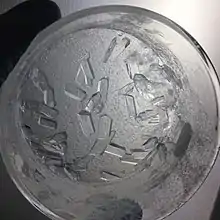Nootkatone
Nootkatone is a natural organic compound, a sesquiterpenoid, and a ketone that is the most important and expensive aromatic of grapefruit,[2] and which also occurs in other organisms.
 | |
 | |
-nootkatone-from-xtal-3D-bs-17.png.webp) | |
| Names | |
|---|---|
| IUPAC name
4α,5α-Eremophila-1(10),11-dien-2-one | |
| Systematic IUPAC name
(4R,4aS,6R)-4,4a-Dimethyl-6-(prop-1-en-2-yl)-4,4a,5,6,7,8-hexahydronaphthalen-2(3H)-one | |
| Other names
(+)-nootkatone | |
| Identifiers | |
3D model (JSmol) |
|
| ChEBI | |
| ChEMBL | |
| ChemSpider | |
| ECHA InfoCard | 100.022.840 |
| KEGG | |
PubChem CID |
|
| UNII | |
CompTox Dashboard (EPA) |
|
| |
| |
| Properties | |
| C15H22O | |
| Molar mass | 218.340 g·mol−1 |
| Appearance | Clear or white crystals, impure samples appear as a viscous yellow liquid |
| Density | 0.968 g/mL |
| Melting point | 36 °C (97 °F; 309 K) |
| Boiling point | 170 °C (338 °F; 443 K) |
| Insoluble in water, very soluble in ethanol, dichloromethane, ethyl acetate, soluble in hexanes | |
| Hazards | |
| GHS labelling:[1] | |
 | |
| Warning | |
| H317 | |
| P280 | |
| Flash point | ~ 100 °C (212 °F; 373 K) |
| Related compounds | |
Related terpenes |
Valencene |
Except where otherwise noted, data are given for materials in their standard state (at 25 °C [77 °F], 100 kPa).
Infobox references | |
Previously, nootkatone was thought to be one of the main chemical components of the smell and flavour of grapefruits. In high purity, it usually is found as colorless crystals. Crude extractives are liquid, viscous, and yellow. Nootkatone typically is extracted from grapefruit through the chemical or biochemical oxidation of valencene. It is found in Alaska yellow cedar trees,[3] as well as in vetiver grass.[4]
Mechanism of action
As is true of other plant terpenoids, nootkatone activates α-adrenergic type 1 octopamine receptor (PaOA1) in susceptible arthropods, causing fatal spasms.[5]
Natural origin
Nootkatone was isolated from the wood of the Alaskan yellow cedar, Cupressus nootkatensis. The species name, nootkatensis, is derived from the language of the Nuu-Chah-Nulth people of Canada (formerly referred to as the Nootka people).[6]
Uses
Nootkatone in spray form has been shown as an effective repellent or insecticide against deer ticks[4][7][8] and lone star ticks.[7][8] It is also an effective repellent or insecticide against mosquitos, and may repel bed bugs, head lice, Formosan termites,[9] and other insects.[10] It is an environmentally friendly insecticide because it is a volatile essential oil that does not persist in the environment.[10] It was approved by the U.S. EPA for this use on August 10, 2020.[11] Its ability to repel ticks, mosquitoes, and other insects may last for hours, in contrast to other plant-based oil repellants like citronella, peppermint oil, and lemongrass oil.[12] It is nontoxic to humans, is an approved food additive,[10] and is commonly used in foods, cosmetics, and pharmaceuticals.[4]
The CDC has licensed patents to two companies to produce an insecticide and an insect repellant.[10] Allylix, of San Diego, California (Now Evolva), is one of these licensees,[13] which has developed an enzyme fermentation process that will produce nootkatone more cost effectively than former processes.[14]
See also
References
- GHS: Sigma-Aldrich 74437 (SDS)
- Furusawa, Mai; Toshihiro Hashimoto; Yoshiaki Noma; Yoshinori Asakawa (November 2005). "Highly Efficient Production of Nootkatone, the Grapefruit Aroma from Valencene, by Biotransformation". Chem. Pharm. Bull. 53 (11): 1513–1514. doi:10.1248/cpb.53.1513. PMID 16272746.
- Panella, NA.; Dolan, MC.; Karchesy, JJ.; Xiong, Y.; Peralta-Cruz, J.; Khasawneh, M.; Montenieri, JA.; Maupin, GO. (May 2005). "Use of novel compounds for pest control: insecticidal and acaricidal activity of essential oil components from heartwood of Alaska yellow cedar". J Med Entomol. 42 (3): 352–8. doi:10.1603/0022-2585(2005)042[0352:UONCFP]2.0.CO;2. PMID 15962787.
- Jan Suszkiw (January 2011). "Lignin + Nootkatone = Dead Ticks". USDA.
- Norris, Edmund J.; Gross, Aaron D.; Kimber, Michael J.; Bartholomay, Lyric; Coats, Joel (2018). "Plant Terpenoids Modulate α-Adrenergic Type 1 Octopamine Receptor (PaOA1) Isolated from the American Cockroach (Periplaneta americana)". Advances in the Biorational Control of Medical and Veterinary Pests. ACS Symposium Series. Vol. 1289. pp. 219–235. doi:10.1021/bk-2018-1289.ch012. ISBN 9780841233591.
- "Cupressus nootkatensis / Nootka cypress | Conifer Species".
- Dolan, MC.; Jordan, RA.; Schulze, TL.; Schulze, CJ.; Manning, MC.; Ruffolo, D.; Schmidt, JP.; Piesman, J.; Karchesy, JJ. (Dec 2009). "Ability of two natural products, nootkatone and carvacrol, to suppress Ixodes scapularis and Amblyomma americanum (Acari: Ixodidae) in a Lyme disease endemic area of New Jersey". J Econ Entomol. 102 (6): 2316–24. doi:10.1603/029.102.0638. PMID 20069863. S2CID 2731012.
- Jordan, Robert A.; Schulze, Terry L.; Dolan, Marc C. (January 2012). "Efficacy of Plant-Derived and Synthetic Compounds on Clothing as Repellents Against Ixodes scapularis and Amblyomma americanum (Acari: Ixodidae)" (PDF). Journal of Medical Entomology. 49 (1): 101–106. doi:10.1603/ME10241. PMID 22308777. Archived from the original on June 18, 2017.
- Zhu BC, Henderson G, Chen F, Maistrello L, Laine RA (March 2001). "Nootkatone is a repellent for Formosan subterranean termite (Coptotermes formosanus)". J Chem Ecol. 27 (3): 523–31. doi:10.1023/a:1010301308649. PMID 11441443.
- Richard Knox (April 18, 2011). "Repelling Bugs With The Essence Of Grapefruit". NPR.
- "EPS approves nootkatone". 10 August 2020.
- McNeil, Donald G. Jr. (2020-08-11). "Citrus Flavoring Is Weaponized Against Insect-Borne Diseases". nytimes.com. Retrieved 2021-07-05.
- Bigelow, Bruce (2011-04-28). "Nootkatone, So A-peeling in Grapefruit, is Repellent to Mosquitoes and Ticks". xconomy.com. Retrieved 10 August 2012.
- "Cost effective fermentation replaces costly extraction". Allylix. Archived from the original on 2012-03-25. Retrieved 10 August 2012.